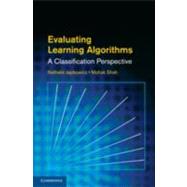
Note: Supplemental materials are not guaranteed with Rental or Used book purchases.
Purchase Benefits
What is included with this book?
| Preface | p. xi |
| Acronyms | p. xv |
| Introduction | p. 1 |
| The De Facto Culture | p. 3 |
| Motivations for This Book | p. 6 |
| The De Facto Approach | p. 7 |
| Broader Issues with Evaluation Approaches | p. 12 |
| What Can We Do? | p. 16 |
| Is Evaluation an End in Itself? | p. 18 |
| Purpose of the Book | p. 19 |
| Other Takes on Evaluation | p. 20 |
| Moving Beyond Classification | p. 20 |
| Thematic Organization | p. 21 |
| Machine Learning and Statistics Overview | p. 23 |
| Machine Learning Overview | p. 23 |
| Statistics Overview | p. 42 |
| Summary | p. 72 |
| Bibliographic Remarks | p. 73 |
| Performance Measures I | p. 74 |
| Overview of the Problem | p. 75 |
| An Ontology of Performance Measures | p. 81 |
| Illustrative Example | p. 82 |
| Performance Metrics with a Multiclass Focus | p. 85 |
| Performance Metrics with a Single-Class Focus | p. 94 |
| Illustration of the Confusion-Matrix-Only-Based Metrics Using WEKA | p. 107 |
| Summary | p. 108 |
| Bibliographic Remarks | p. 109 |
| Performance Measures II | p. 111 |
| Graphical Performance Measures | p. 112 |
| Receiver Operating Characteristic (ROC) Analysis | p. 112 |
| Other Visual Analysis Methods | p. 131 |
| Continuous and Probabilistic Classifiers | p. 137 |
| Specialized Metrics | p. 143 |
| Illustration of the Ranking and Probabilistic Approaches Using R, ROCR, and WEKA | p. 146 |
| Summary | p. 159 |
| Bibliographic Remarks | p. 159 |
| Error Estimation | p. 161 |
| Introduction | p. 163 |
| Holdout Approach | p. 164 |
| What Implicitly Guides Resampling? | p. 167 |
| Simple Resampling | p. 171 |
| A Note on Model Selection | p. 177 |
| Multiple Resampling | p. 178 |
| Discussion | p. 185 |
| Illustrations Using R | p. 187 |
| Summary | p. 202 |
| Bibliographic Remarks | p. 202 |
| Appendix: Proof of Equation (5.5) | p. 204 |
| Statistical Significance Testing | p. 206 |
| The Purpose of Statistical Significance Testing | p. 207 |
| The Limitations of Statistical Significance Testing | p. 210 |
| An Overview of Relevant Statistical Tests | p. 213 |
| A Note on Terminology | p. 215 |
| Comparing Two Classifiers on a Single Domain | p. 217 |
| Comparing Two Classifiers on Multiple Domains | p. 231 |
| Comparing Multiple Classifiers on Multiple Domains | p. 239 |
| Statistical Tests for Two Classifiers on a Single Domain Based on Resampling Techniques | p. 258 |
| llustration of the Statistical Tests Application Using R | p. 263 |
| Summary | p. 289 |
| Bibliographic Remarks | p. 290 |
| Datasets and Experimental Framework | p. 292 |
| Repository-Based Approach | p. 294 |
| Making Sense of Our Repositories: Metalearning | p. 300 |
| Artificial Data Approach | p. 301 |
| Community Participation: Web-Based Solutions | p. 304 |
| Summary | p. 306 |
| Bibliographic Remarks | p. 306 |
| Recent Developments | p. 308 |
| Performance Metrics | p. 309 |
| Frameworks for Performance Metrics | p. 312 |
| Combining Metrics | p. 317 |
| Insights from Statistical Learning Theory | p. 323 |
| Other Developments | p. 329 |
| Summary | p. 330 |
| Appendix: Proof of Theorems 8.1 and 8.2 | p. 330 |
| Conclusion | p. 335 |
| An Evaluation Framework Template | p. 336 |
| Concluding Remarks | p. 349 |
| Bibliographic Remarks | p. 350 |
| Statistical Tables | p. 351 |
| The Z Table | p. 351 |
| The t Table | p. 352 |
| The x2 Table | p. 353 |
| The Table of Critical Values for the Signed Test | p. 355 |
| The Wilcoxon Table | p. 356 |
| The F-Ratio Table | p. 357 |
| The Friedman Table | p. 361 |
| The Table of Critical Values for the Tukey Test | p. 362 |
| The Table of Critical Values for the Dunnett Test | p. 363 |
| Additional Information on the Data | p. 364 |
| Two Case Studies | p. 368 |
| Illustrative Case Study 1 | p. 368 |
| Illustrative Case Study 2 | p. 375 |
| Bibliography | p. 393 |
| Index | p. 403 |
| Table of Contents provided by Ingram. All Rights Reserved. |
The New copy of this book will include any supplemental materials advertised. Please check the title of the book to determine if it should include any access cards, study guides, lab manuals, CDs, etc.
The Used, Rental and eBook copies of this book are not guaranteed to include any supplemental materials. Typically, only the book itself is included. This is true even if the title states it includes any access cards, study guides, lab manuals, CDs, etc.